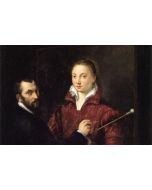Art of the Northern Renaissance
This course will be delivered online. See the ‘What is the course about?’ section in course details for more information.

This course has now started
- Course Code: VB434
- Dates: 25/04/24 - 04/07/24
- Time: 10:30 - 12:30
- Taught: Thu, Daytime
- Duration: 10 sessions (over 11 weeks)
- Location: Online
- Tutor: Elizabeth Eyres
Course Code: VB434
Duration: 10 sessions (over 11 weeks)
Please note: We offer a wide variety of financial support to make courses affordable. Just visit our online Help Centre for more information on a range of topics including fees, online learning and FAQs.
What is the course about?
When we think of the Renaissance we usually think of Italy, in particular Florence and Rome. Yet from around 1400 to 1600 there were arguably equally significant cultural advances in northern Europe, which for the purposes of this course includes the modern day countries of the Netherlands, Switzerland, Belgium, France and Germany. Many artists in these countries had the desire to make images of the visible world more believable and accessible, humanizing art and culture in the process. The paintings are often jewel-like in their precision, rendered with astonishing realism, skill and clarity. Sculpture from this period tends to be either charmingly naïve or remarkably life-like.
Northern Renaissance paintings, perhaps surprisingly, had a significant influence on the Italian artists of the Early Renaissance, often through the Florentine patrons who admired and collected these northern European works, resulting in the spread south of the use of oil paint, with its greater potential for realism. Thus the advances in the north and south of Europe resulted in a two-way process: Dürer, for example, travelled to Italy to further his career, becoming one of the first international artists, and brought back to his native city of Nüremberg, in Germany, a number of innovations and changes.
This course will look at the artistic production in these northern European countries from the beginning of the 15thcentury to the end of the 16th, looking at contexts and debates surrounding the idea of the Northern Renaissance and enjoying and analysing some astoundingly beautiful paintings along the way.
This is a live online course. You will need:
- Internet connection. The classes work best with Chrome.
- A computer with microphone and camera is best (e.g. a PC/laptop/iMac/MacBook), or a tablet/iPad/smart phone/iPhone if you don't have a computer.
- Earphones/headphones/speakers.
We will contact you with joining instructions before your course starts.
What will we cover?
• The paintings, prints and sculptures of significant Northern Renaissance artists
• Cultural contexts of northern Europe at this time
• The cross-fertilization of northern and southern cultures during this period
• The work of the Northern Renaissance’s most innovative artists, including Albrecht Dürer, Rogier van der Weyden, Jan van Eyck, Grünewald, Hieronymus Bosch and Pieter Bruegel the Elder.
What will I achieve?
By the end of this course you should be able to...
• You will be able to identify the key features of Northern Renaissance art from this period
• You will be able to name and identify the works of Northern Renaissance artists
• You will be able to explain how the techniques used by these artists affects the appearance of these works
• You will be able to compare and contrast Northern Renaissance works with their Italian counterparts.
What level is the course and do I need any particular skills?
The course is open to all. No prior knowledge of the subject is required other than a general interest in art.
You should be able to follow simple written and verbal instructions, demonstrations, hand-outs and health and safety information as well as basic functions of Zoom, specifically microphone and camera.
How will I be taught, and will there be any work outside the class?
You will be taught with short lectures, slide shows and discussions.Reading materials will be available online/digitally for download via a Google Classroom. You will be invited to join this Google Classroom within a week of the start of your course.
Are there any other costs? Is there anything I need to bring?
You might wish to bring a notebook. You might wish to buy some of the books on any reading list given out in class.
When I've finished, what course can I do next?
You might also be interested in:
Art of the Burgundian Netherlands
Art and identity: from the High Renaissance to the Reformation.
Liz Keevill Eyres worked as a textile designer in the fashion industry for four years and then as a magazine journalist specializing in interior design for 13 years. Her first degree was at Camberwell School of Art which she did at the same time as completing a degree in History and Art History with the Open University. Liz studied and has taught at Kingston University, where she lead modules and lectured in history of art, design history and architecture for ten years and ran study visits both at home and abroad. Liz has researched into English Modernist textile design of the 1950s and the professional practice of the provincial Edwardian architect, in particular Norwich-based architect George Skipper.
Please note: We reserve the right to change our tutors from those advertised. This happens rarely, but if it does, we are unable to refund fees due to this. Our tutors may have different teaching styles; however we guarantee a consistent quality of teaching in all our courses.
